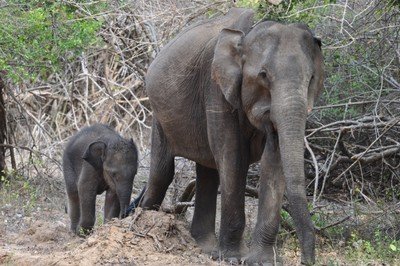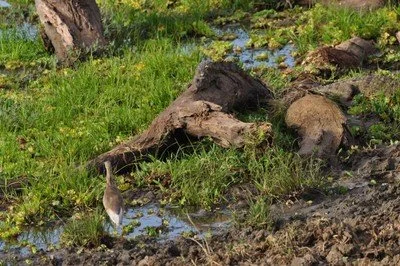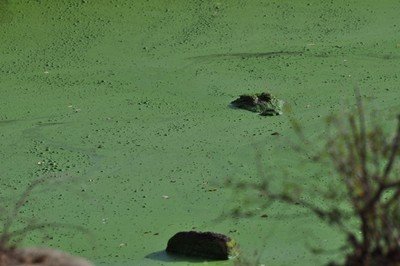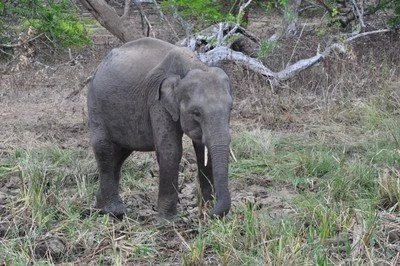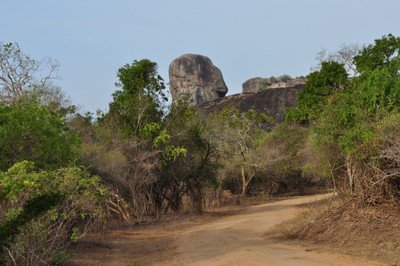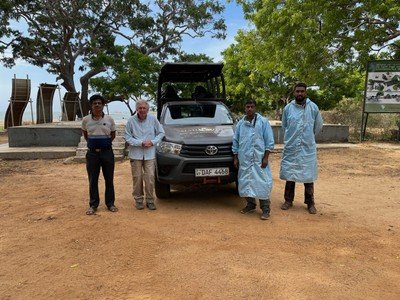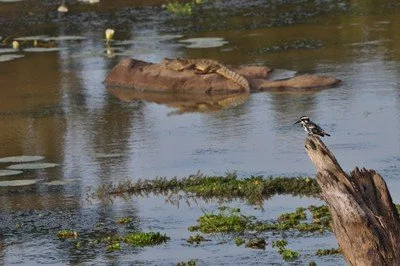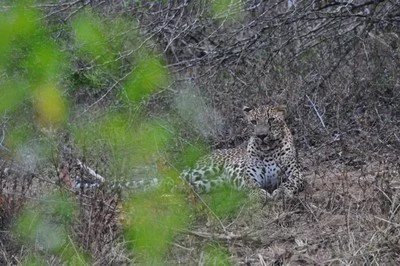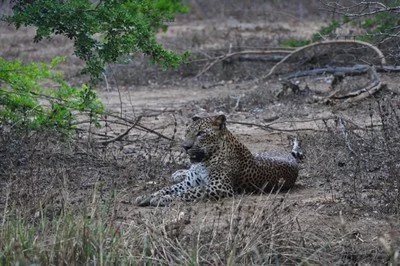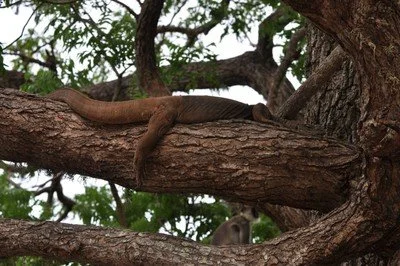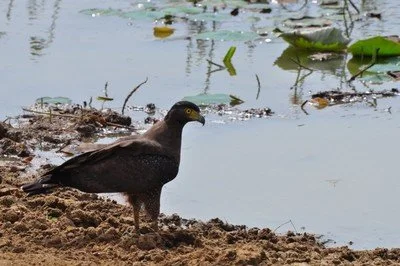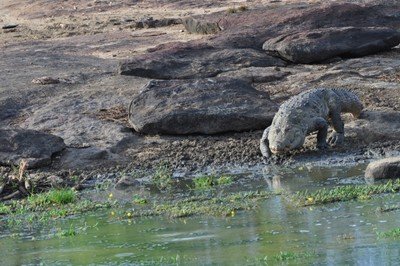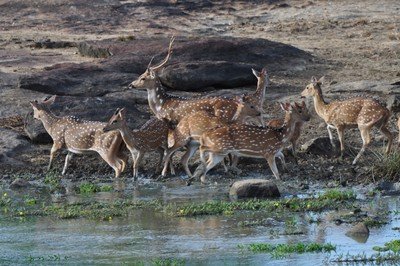7. Suba Daba Doo
Wild Ride to a Wild End
08.13.2021 - 08.13.2021 93 °F
View Paul to Yala Land on paulej4's travel map.
Chapter 7, August 13, 2021
Driving in a way that the BMW Driving Experience training team would praise and envy, Nishantha is a man on a mission. Yala Park Official Mr. Balawikrama—who has ridden shotgun on each of our game drives—has received a message. Shiram who is driving Sri Lankan Parliament Opposition Leader Mr. Sajith Premadasa at Galalukada Lake, has spotted a leopard.
We are, only a half-hour after entering the park, 6 kilometers distant. Nishantha is not to be deterred. From Sathmaga Road, we race past Pendasvilla water hole and then Sathwilla. It is fifteen minutes of controlled mayhem, twisting and turning on single late rutted and pocked track, sometimes deep sand mixed with dust and other times rock hard macadam-like unforgiving hardness. The bush tries to envelope us, causing Avinka and I both—in the elevated back of the Toyota—to lean in when thorns threaten to slice us from branches too close for comfort. Nishantha, I later learn, got his driver’s license in 2003 and began driving full-time for Mahoora in 2014. He speaks very little English but communicates with head bobs and his eyes. His smile, like all of our smiles, is covered by a COVID mask but his enthusiasm for this chase is clear. His pride is on the line. If there is a leopard at Galalukada Lake, then his client, me, is going to see it.
Our reward is Suba, a year-and-a-half old male who is surveying the spot where we have visited many times, just opposite a stork nest where chicks are being fed and a crocodile lies in wait below. But we pay no mind to them; this is Suba’s show and he is the star. Suba’s name, I am later told, translates to ‘something good.’ And that, dear friend, is apt.
After fifteen minutes or more, Suba tires of his spotlight and the half-dozen tourist trucks who fill his theater and retires to the wings. We—and all the others--try to follow but the bush is dense and the rocks are huge.
We bask in what has just happened and pass Tank Rock, near Human Rock, viewing an expansive water hole with birds and spotted deer and a curious crocodile. Later, we are stopped by the remains of a deceased elephant. I have been wondering why I am seeing so few bones of the departed strewn about but that is the case. With no hyena or wild dog or even vulture to devour all of this, I wonder what happens to the scraps from the leopard’s meal.
We pass by another vehicle, this one from Wild Coast camp, a facility not unlike Mahoora’s, carrying like us a single caucasian tourist/photographer. This morning, they have seen nothing. It is like that with safari. You must be in the right place at the right time, perhaps helped to get there by friends on the radio or mobile phone, and near enough to make the journey before the object of your interest retires to a hidden retreat...even if it is a land monitor (lizard) in a tree. It helps to have a great team and that is what I have in Avinka, Nichantha and Mr. Balawikrama. I am fortunate to have fallen under their care.
I am delivered back at tent 16 after 10:00, nearly five hours after having left it richer by far.
Given that I owe my Suba sighting to a politician, this is as good a time as any to talk politics. Opening the New York Times on a July Sunday morning—just four weeks before this August trip—this headline grabbed me: “Sri Lanka’s Government Resembles Family Firm as Tensions in the Country Mount.” The sub-head read “Five of the president’s relatives now hold official positions.” That is better than the Kennedy, Bush, Clinton or Trump families could accomplish.
Gotabaya Rajapaksa, 72, is the president of Sri Lanka and, also, defense minister.
Mahinda Rajapaksa, Gotabaya’s brother, (and former two-term president), 75, is prime minister and in charge of the Ministries of Religious Affairs and Urban Development.
Basil Rajapaksa (another presidential brother), 69, is finance minister.
Chamal Rajapaksa (the president’s eldest brother), 78, is minister of irrigation and state minister of home affairs and of national security and disaster management.
Namal Rajapaksa (Mahinda’s son), 35, is minister of youth and sports as well as state minister of digital technology and enterprise development.
Sasheendra Rajapaksa (Chamal’s son) is minister of state for paddy and cereals, organic food, vegetables, fruits, chilies, onions and potatoes, seed production and high-tech agriculture.
An opposition lawmaker, Harsha De Silva, is quoted in the Times article as saying, “The Rajapaksas believe that expertise lies only among their family—that if one brother can’t do, the next brother will try, and if that fails, a third brother will do.”
Problems have put extreme pressure on Sri Lanka. While then president Mahinda Rajapaksa ended Sri Lanka’s “decades-long” civil war in 2009, finally defeating the Tamil Tigers, on Easter Sunday, 2019, simultaneous bombings took the lives of more than 250 people. That attack helped unite voters who soon overwhelmingly elected Gotabaya Rajapaksa president. Then COVID hit and Sri Lanka, like other countries, implemented strict restrictions including closing borders to tourists like me. The country suffers under a mountain of debt. A recent maritime fire created an environmental disaster on the island nation’s northwest beaches. War crimes trials have roiled the populous. There was a monsoon in June which caused floods and landslides which resulted in thousands being displaced from their homes.
Then, to add insult to injury, one of the country’s cricket officials (not a relative) was banned from the sport for trying to bribe the country’s sports minister (also not a relative) while cricket player Bhanuka Rajapaksa, 29, (who is a relative) was fined $5,000 and suspended for criticizing the country’s national cricket board during interviews. His coach countered that Bhanuka “failed to comply with the skin fold tests in order to fulfill the required fitness levels to play in international cricket matches.” How many of us could pass a skin fold test?
At dinner back in May, neighbor Owen Buckley asked, “Why Sri Lanka?” At my answer, he looked at me with a bewildered face and followed up with this question: “After just getting through COVID, why in the world would you do that?”
His second question was prompted by my poorly enunciated reply to his first question. He thought I had said “leper safari,” when I had meant to say, “leopard safari.” The four of us at the table (B4, Lynn, Owen and I) got a hearty laugh at my mispronounced motivation. Actual Destination: Democratic Socialist Republic of Sri Lanka, better known simply as Sri Lanka, once known as Ceylon. Why was that appealing? I’ve photographed cheetah and lion in several African countries, jaguar in Brazil, tiger in India. But other than decades ago spotting what I think was one leopard in an African tree, I’ve not experienced this remaining big cat in the wild.
By now you may have consulted a map but if not: Sri Lanka lies in the Indian Ocean, south and west of the Bay of Bengal, south and east of the Arabian Sea. It might be easier to visualize with that map; India is but 18 nautical miles to the north and west. Colombo, with a diverse metropolitan population of 5.6 million people, is the largest city in Sri Lanka. Just over 20 million people, mostly Buddhist with large Hindu and Muslim minorities, reside in nine Sri Lankan provinces. Population data indicates there are some Christians but few to no Jews. Still a “developing nation,” one hurdle is being quickly overcome as more than 90 percent of Sri Lankans are literate; primary and middle school education is compulsory so almost all youth can read and write. A bit over one third of Sri Lankans are computer literate. Not everything is up to date: Article 365 of the Sri Lankan Penal Code criminalizes (but seldom prosecutes) gay sex. Even so, the country has implemented anti-discrimination policies for LGBT persons; the legal right to change one’s gender on official documents exists even though both same-sex marriage and adoption do not.
English is spoken by 25% of the population, Sinhala or Singhalese by 87% and Tamil by 29%. A look at the alphabets will help you to understand the difficulty of speaking more than one of these.
The government is led by a president who is elected for a five-year term and can be re-elected only once. The legislative branch is a unicameral parliament (like Nebraska) with 225 members. Like us they have a supreme court that interprets what amounts to primarily British law. Two parties—a center left progressive United People’s Freedom Alliance vies for power with a mostly right-wing pro-capitalist United National Party but there are 67 registered political parties here so it is not all that simple.
Sri Lanka knows both tragedy and violence: 35,000 died in 2004 during a tsunami which crashed into the beach where I have now had my breakfast on two occasions and from 1985 through 2006 the government and Tamil insurgents fought resulting in the deaths of between 60,000 and 100,000 citizens. As earlier noted, the Tamil “Tigers” have not been much heard from since 2009.
During the three-decade-long civil war Buddhists fought Tamil groups which are largely Hindu. Tribalism and sectarian divides still exist. Just three years ago Buddhists mobs attacked minority Muslim businesses and homes. Between 200 and 300 Christians were killed in those Easter 2019 bombings. Outsiders don’t help: both India and China compete for influence here with the latter extending massive loans on both failed and successful projects creating what the New York Times called a “debt trap” for Sri Lanka as part of China’s Belt and Road Initiative. Air and water pollution accompanied by climate change threaten the people here.
There is much history. Since 1505, the Portuguese, then the Dutch and later the British laid claim to this island which was then commonly known as Ceylon. Independence came on February 4, 1948.
The climate is tropical but frost has been known to occur in the highlands in wintertime. This August, I am experiencing highs in the low nineties with lows just dipping into the high seventies. It is hot to sleep on my tent but the fan helps. The southwest monsoon season (not here in the southeast) is ending about now but high tourist season is still weeks away. With COVID, they may have to go another year without a high tourist season. As noted, I am one of the rare foreigners to be seen in Yala even though the internet informs one and all that this is a good time to visit Yala National Park, home to the highest concentration of leopards anywhere in the world. You know that has proven correct.
What of the Sri Lankan flag? Its main feature is a lion holding a sword symbolizing bravery but there are no lions here. Around 486 BC, Vijaya came here from India to be the first king. He brought the lion symbol with him and it has remained. Four Bo (sacred fig) leaves decorate the flag’s corners symbolizing “loving kindness,” “compassion,” “equanimity” and “happiness.” Green represents Muslims, the orange Hindus and the crimson background is for everybody else.
I have been well served in planning this journey by government employees, Jetwing Hotel employees including Geeshani Wickramarathine and the tour company with whom I contracted, Mahoora EcoTeam, led by the incomparable Nathasha Piumali. Nathasha, the real key to this entire adventure, has fixed and re-fixed and assured and re-assured when I felt the trip would have to be canceled.
Frankly, in all my travels I cannot recall more people extending more effort to solve a multitude of COVID related travel restrictions, red tape, visas, permitting, ground transport, lodging issues, quarantines, PCR tests and more. Without them I would have given up on Sri Lanka long ago and found a different spot to burn my Emirates Airlines miles before they went up in smoke all on their own. Had I made that mistake, I would have missed out on what I now believe to be one of the planets premier safari destinations—underdeveloped and under appreciated by tourists and vagabonds like me.
The afternoon game drive, of course, once again proves the mettle and dedication of Avinka and Nichantha and the involvement of Mr. Balawikrama. In the photo, it is Mr. Balawikrama, Me, Nishantha and Avinka (we all momentarily removed our masks just for the photo). The three of them spot things impossible to spot, find things impossible to find and get to places in the nick of time. More elephant sightings and extended interactions; more leopard sightings with fleeting interactions save one extended visit. Each wonderful in its own way. Block One of Yala National Park is an amazing place, thriving with life and experiences. I'm exhausted from it all.
